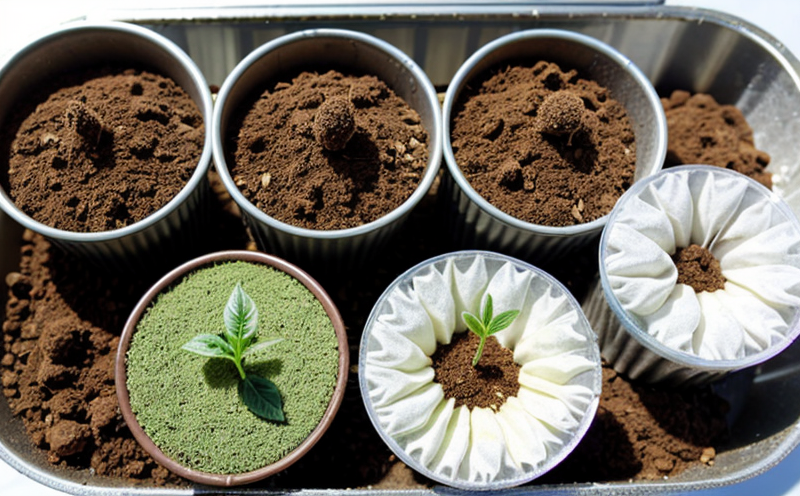Seed Quality & Germination Testing
The quality of seeds is a critical factor in determining crop yields and overall agricultural productivity. Ensuring that seeds meet specific standards before planting can significantly impact the success of any farming operation. In agriculture, seed quality testing encompasses several aspects including purity, vitality, and germination rate. Seed germination testing specifically evaluates how well seeds will grow into healthy plants under controlled conditions.
Seed quality is determined by a variety of factors such as size, shape, color, and integrity. These attributes are assessed using various analytical techniques that include visual inspection, mechanical analysis, and chemical analysis. Seed purity checks involve separating out unwanted plant species or other materials from the seed lot to ensure uniformity.
Germination testing is often conducted under standardized conditions prescribed by international standards such as ISO 3632:1988 Annuaria. This standard provides guidelines for determining the germination percentage of seeds, which indicates how many seeds will likely grow into plants. The test typically involves placing a set number of seeds in moistened filter paper or sand within a controlled environment where temperature and humidity levels are closely monitored.
Once the seeds have been planted, they are observed over time to record their germination rates. Seedlings that fail to emerge after the prescribed period may indicate poor quality seeds. It is also important to note that some seeds require stratification or chilling treatments before they can successfully germinate; this information should be considered when planning tests.
Proper seed quality testing ensures consistent performance across different regions and seasons, reducing risks associated with substandard products entering the market. For example, imported seed lots from countries known for inconsistent quality might need additional scrutiny compared to domestically produced seeds.
The importance of accurate germination testing cannot be overstated in ensuring successful crop establishment and long-term profitability for farmers. By accurately assessing seed viability early on, producers can make informed decisions about which varieties to plant based on expected yields and other agronomic factors.
Why It Matters
Accurate germination testing is essential for maintaining high standards in agricultural practices. Poorly performing seeds not only waste valuable resources but also have significant implications for environmental sustainability, economic efficiency, and food security.
- Economic Efficiency: Suboptimal seed quality can lead to higher production costs due to increased labor requirements for replanting failed areas or purchasing replacement seeds. Additionally, lower yields result in reduced profitability per unit area cultivated.
- Environmental Sustainability: When poor-quality seeds are planted, they may not establish properly leading to increased use of pesticides and fertilizers as farmers attempt to correct deficiencies. This increases non-targeted pollution risks affecting local ecosystems.
- Food Security: Consistent access to nutritious food depends heavily on reliable agricultural practices. Ensuring that only high-quality seeds reach markets helps maintain steady supplies without disruptions caused by low-yielding plants.
In summary, investing in comprehensive seed quality and germination testing programs contributes directly to improved farm management practices, enhanced crop performance, and more robust supply chains.
International Acceptance and Recognition
Seed quality and germination testing are recognized globally through several key international standards. These include ISO 3632:1988 Annuaria, which provides guidelines for determining the percentage of seeds that will germinate successfully.
- ISO 3632: This standard outlines methods and procedures used to establish seed purity, viability, and vigor. It specifies conditions necessary for accurate testing, such as temperature, humidity, light intensity, and duration.
- EN ISO 17025: Laboratories conducting these tests must adhere to this accreditation requirement ensuring they meet stringent technical criteria for quality assurance.
Compliance with international standards enhances credibility within both domestic and export markets. Adherence to recognized protocols ensures that results are comparable across borders, fostering trust among buyers and sellers alike.
Furthermore, many countries have adopted these internationally accepted practices into their national regulations further emphasizing the importance of rigorous quality control measures during seed processing.
Competitive Advantage and Market Impact
- Innovation Leadership: Companies that invest in advanced analytical equipment capable of detecting even minute differences between seed lots gain competitive advantages by offering superior products. This allows them to cater better to niche markets demanding unique traits or resistance to pests.
- Premium Pricing: Premium prices can be achieved when suppliers deliver consistently high-quality seeds backed by robust testing protocols demonstrating reliability and consistency.
- Market Share Growth: By ensuring compliance with international standards, companies establish themselves as reliable partners for large-scale growers who require standardized inputs. This leads to increased market share particularly in export-oriented segments.
- Sustainability Focus: Emphasizing sustainable practices during seed production aligns directly with growing consumer demand towards eco-friendly agricultural solutions. Such initiatives contribute positively towards brand image and customer loyalty.
The combination of adherence to international standards, innovative testing technologies, and commitment to sustainability creates a comprehensive strategy that enhances overall competitiveness in the global market.





